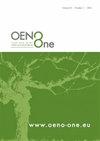研究葡萄莓对热胁迫反应的移动装置
IF 2.2
3区 农林科学
Q3 FOOD SCIENCE & TECHNOLOGY
引用次数: 0
摘要
在田间对不同品种葡萄果实热胁迫反应的重复性比较常常受到生长季节天气条件的限制。这项工作提出了一个移动加热装置能够控制热应力诱导葡萄藤浆果。加热器由六个150w的红外灯组成,安装在一个侧面框架中。灯的加热功率可以由一个由单板计算机和六个温度传感器组成的控制单元单独设置。应用于单个浆果在一个集群内的热能减少平方距离的热源,使建立温度分布在单个集群内。水果表面的红外热成像和在表皮水平插入热电偶进行的测量显示出相当的温度。根据其视觉外观(即晒伤症状)对经过高温处理的浆果进行取样。只有有症状的浆果显示电解质泄漏显著增加,表明细胞损伤。在田间试验中,利用该装置诱导葡萄品种巴克斯和西万尼的晒伤坏死症状,预测其致死剂量(LD50)。热敏感品种巴克斯的LD50比西万尼低3.2℃左右。该装置提供了广泛的应用和在肉质水果热应力背景下精确温度动态感应的可能性。本文章由计算机程序翻译,如有差异,请以英文原文为准。
A mobile device to investigate the response of grapevine berries to heat stress
Reproducibly comparing the heat stress response of grapevine berries from different cultivars in the field is often limited by weather conditions during the growing season. This work presents a mobile heating device capable of controlled heat-stress induction on grapevine berries. The heater consisted of six 150 W infrared lamps mounted in a profile frame. The heating power of the lamps could be set individually by a control unit consisting of a single board computer and six temperature sensors positioned as desired. The heat energy applied to individual berries within a cluster decreases by the squared distance to the heat source, enabling the establishment of temperature profiles within individual clusters. Infrared thermography of the fruit surface and measurements conducted with a thermocouple inserted at the epidermis level showed comparable temperatures. Berries treated with high temperatures were sampled according to their visual appearance (i.e., sunburn symptoms). Only symptomatic berries showed a significant increase in electrolyte leakage, indicating cell damage. In a field experiment, the induction of sunburn necrosis symptoms with the presented device was used to predict a Lethal Dose (LD50) for sunburn necrosis symptoms of the Vitis vinifera L. cultivars Bacchus and Silvaner. The LD50 of Bacchus, known as a heat-sensitive cultivar, was about 3.2 °C lower than that of Silvaner. The presented device offers possibilities for a wide range of applications and the induction of precise temperature dynamics in the context of heat stress on fleshy fruit.
求助全文
通过发布文献求助,成功后即可免费获取论文全文。
去求助
来源期刊

OENO One
Agricultural and Biological Sciences-Food Science
CiteScore
4.40
自引率
13.80%
发文量
85
审稿时长
13 weeks
期刊介绍:
OENO One is a peer-reviewed journal that publishes original research, reviews, mini-reviews, short communications, perspectives and spotlights in the areas of viticulture, grapevine physiology, genomics and genetics, oenology, winemaking technology and processes, wine chemistry and quality, analytical chemistry, microbiology, sensory and consumer sciences, safety and health. OENO One belongs to the International Viticulture and Enology Society - IVES, an academic association dedicated to viticulture and enology.
 求助内容:
求助内容: 应助结果提醒方式:
应助结果提醒方式:


